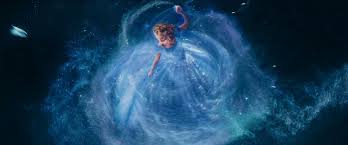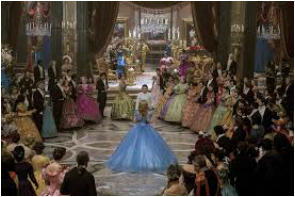The remake of the Disney animated classic has now been released. I suppose now I should compare and contrast the two. The original movie had a nice sense of comedic timing, a good heart, and an apt villain in the evil stepmother. In later years Walt Disney Pictures released two sequels, the first making me cringe just thinking about it, and the second one ultimately perplexing and delighting me at the same time, though I did feel like it, too, was a money grab.
Speaking of which, before one goes into this movie you wonder why else Disney would be releasing all these up-and-coming remakes of their classics except for that greedy bit of "dinero en efectivo". I don't know for certain how the reissues of those other treasures will turn out, but if they are handled in the same way as Maleficent and this Cinderella, then they will also be painted with new coats of makeup over the original vintage exteriors, sometimes to surprising effect.
That effect is felt in this movie. The costumes, the architecture, even the looks and attitudes of the characters spell the words "fresh" and "crisp". The idea of placing an African American in the role of the Captain looks inspired, as does the whole shebang.
But there are certain other things to note. For one, this film has lost much of its comedy in transition. No, there is still some. Just not enough to reach the heights of such scenes in the 1950 film with the mice trying to get things accomplished with Lucifer the cat skulking about. Yes, the step sisters are still a big comedic outlet, copying some of the exact same traits from animation, though the hilarity isn't as bloated as the persona of the drawn, pointed girls' faces and the slapstick-like, boisterous actions that accompany them.
The heart of this remake is still in the right place, as evidenced in the personal scenes given to the individual characters. Yet the drama sometimes doesn't have such a heavy weight as it once did. Before the ball, not much of the cruelty Cinderella has faced is shown, and the scene where the relatives-by-law tear her dress and she runs off crying isn't as shocking because, as a matter of fact, in this version the dress is only briefly attacked and not with a whole lot of intensity.
In the original, the aging stepmother is viewed as menacing and cool with unpredictability and elegant, collected prowess. Cate Blanchett is given a few places in this update where she gets to flaunt her deviousness, but she is no longer one we feel we have to tiptoe around, her character now imbued with some actual humanity, just not enough to get us too entranced with the relatively weak plot.
You heard me. Weak plot. I have always found the story of Cinderella to be one of the least deserving tales in the past four centuries or so to get the attention that it has been given. The thing that stands out the most is that Cinderella and the Prince fall in love after little interaction and plan on getting hitched to each other. Prince Charming in this version, thank God, has a bit more than just a pretty face to his name. Another plot deficiency is that most of the tale takes place during the time after the ball invites are given out and Cinderella fleas from the said occasion. This time period typically encompasses too many extraneous scenes that don't add much to plot or characterization, save for the dress-ripping sequence, and mainly serves only for the fantasy backbone of the Fairy Godmother and her gifts. To bring about a satisfying experience from these place-holding proceedings is not too easy, and can only be achieved if the main focus of the film is on the scenes before the ball notice goes out and after the Prince starts searching for the strange girl who left behind her glass slipper. With the former, more is now provided, but containing mostly the couple preludes before and between the deaths of Cinderella's biological family, and not more of what we do need: to see more cruelty given by the new family to encourage us to get excited over the bits where poor Cinderella tries to reach her happy ending and escape an abusive household. The 1950 film captured that well, and provided more compassion for Cinderella because she loses her family and is exposed to adversity from other human beings at a very young age, becoming a very shy person that lets others push her around too often. Unlike that film, this Cinderella is already a teenager and almost fully developed when she is made a labor slave, so she is more rebellious and outspoken.
My favorite adaptation of Cinderella so far is still the one in which Drew Barrymore stars, where political subtext is handled in a charming, post-feminist way throughout, all the characters have life and are not thin caricatures, and the plot and story are fully realized.
With this new film, the stars are likeable and the cinematography, visuals, and settings are gorgeous and pleasing to the eyes. In the end, though, the portions of the film that are given the most focus matter the most, especially with a thin, easy-to-be-unfocused tightrope of a plot like this.
Sadly, this movie in that area is more give-and-take.


 RSS Feed
RSS Feed
